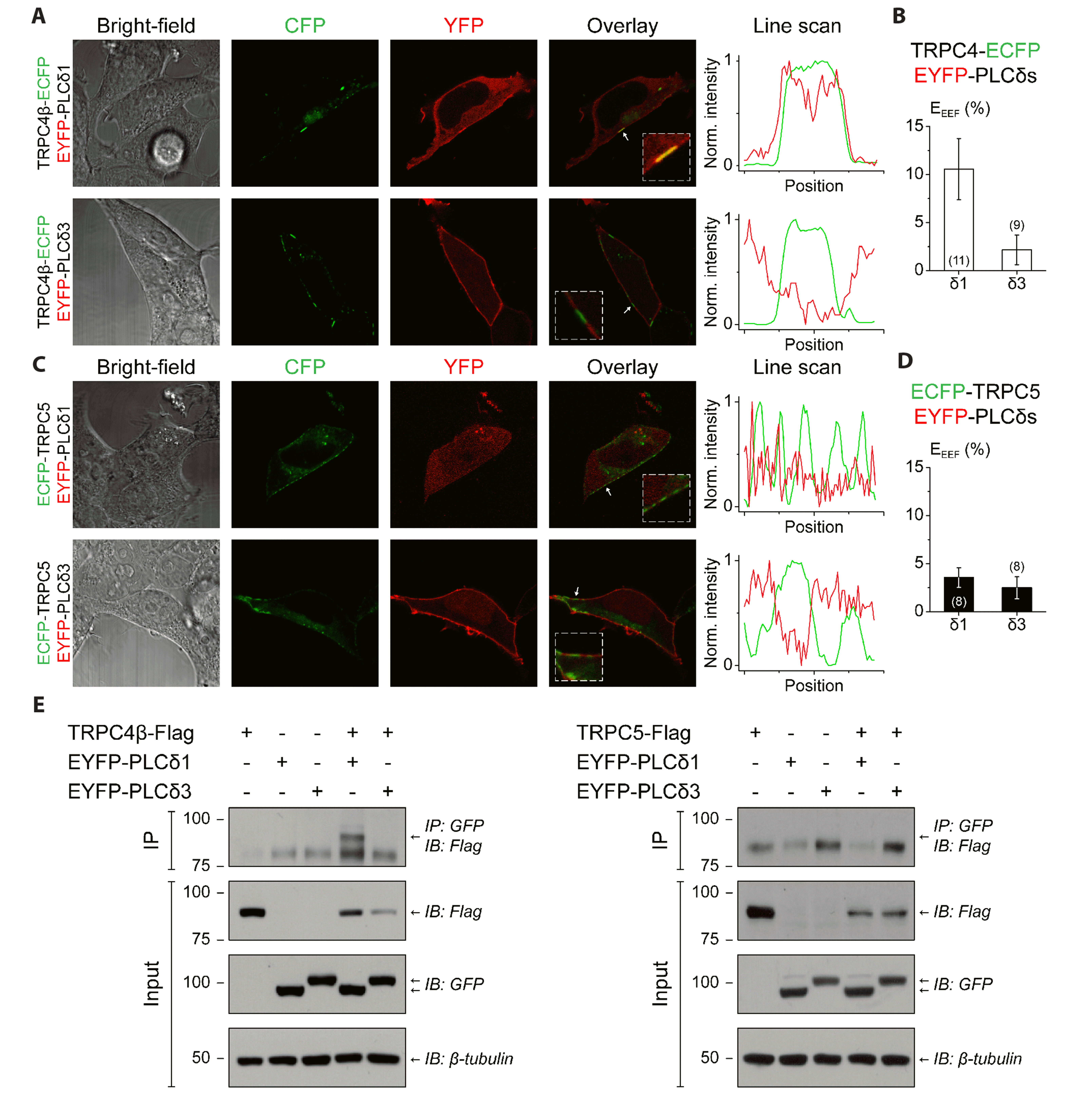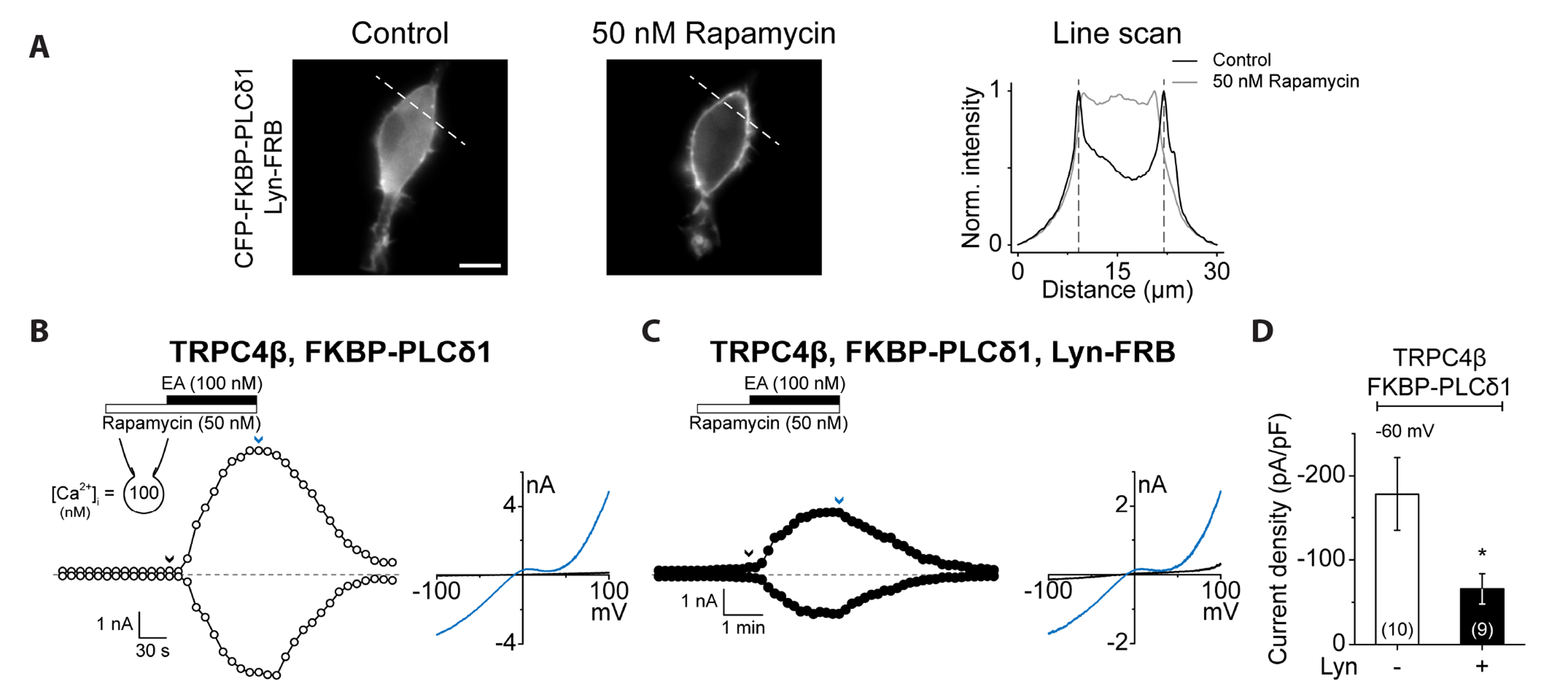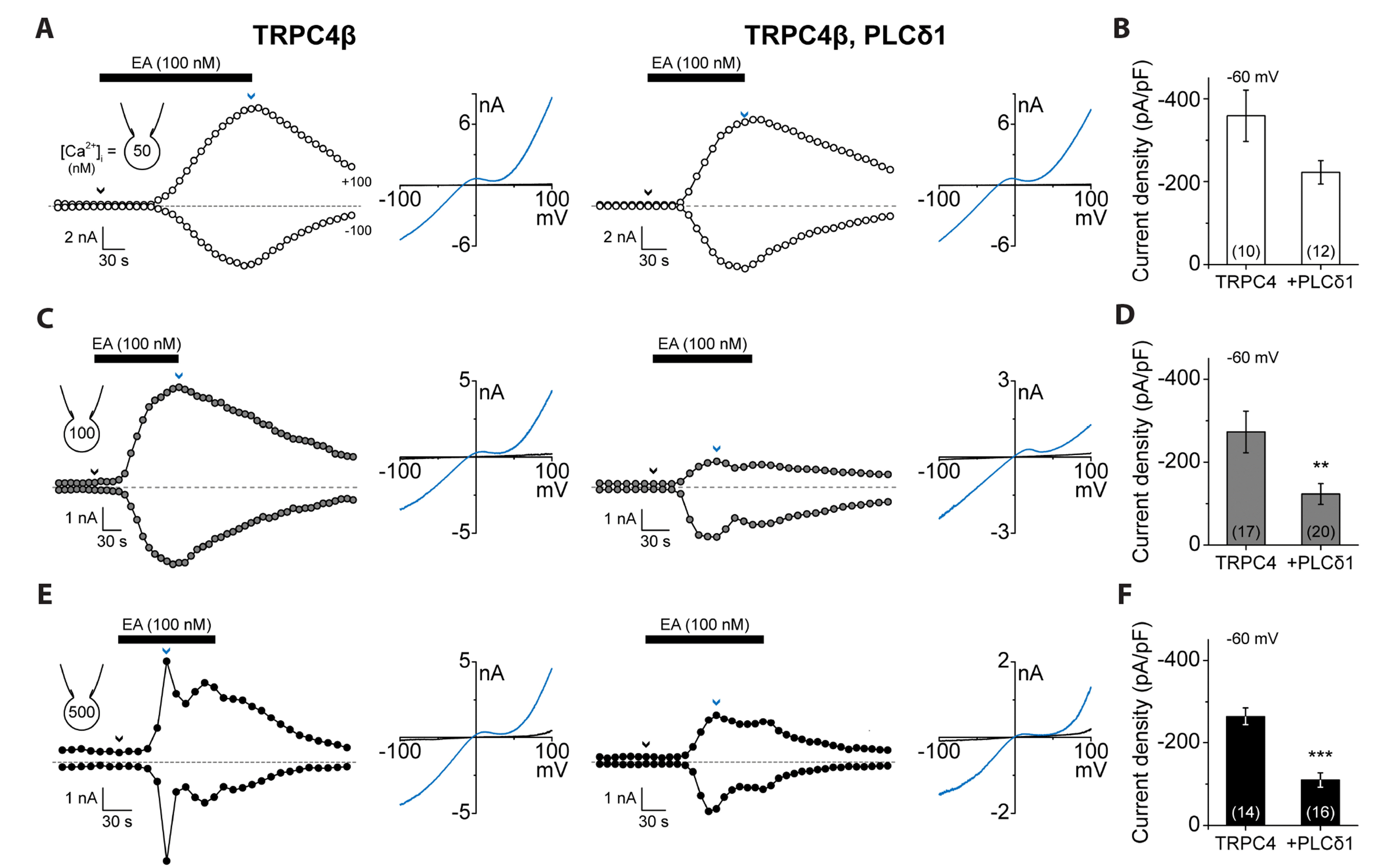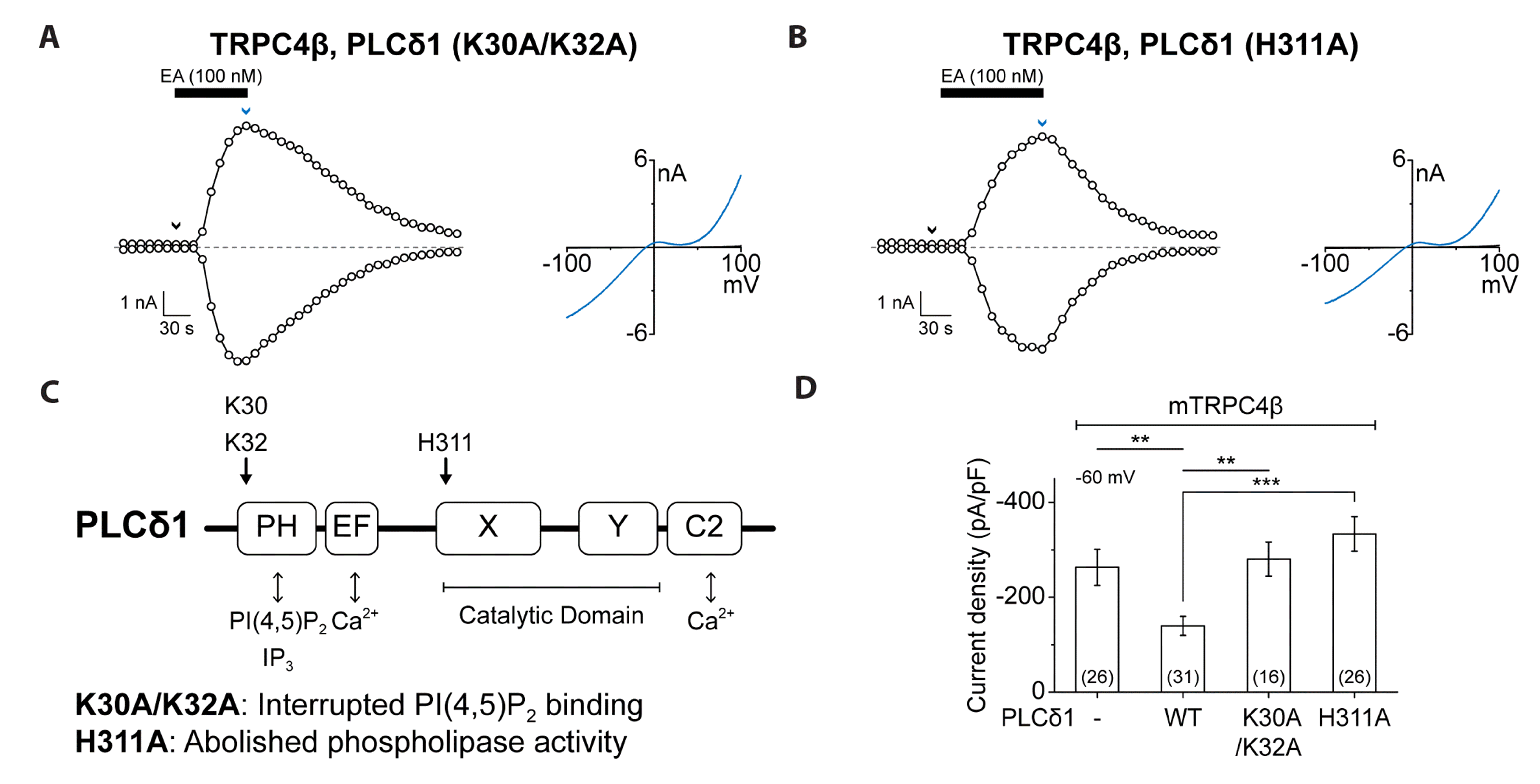INTRODUCTION
Transient receptor potential (TRP) channels are nonselective cation channels which are permeable to Ca
2+. Among TRP channels, this canonical family is composed of 7 types, and they are subdivided into two groups based on their amino acid sequence and structure; TRPC1, 4, 5 and TRPC3, 6, 7. Interestingly, TRPC4 is functionally analogous to TRPC5, but only TRPC5 shows constitutive activity even without stimulation. However, the mechanism that makes this difference still remains obscure. The activity of TRPC4 and TRPC5 are closely related to Gα
q-phospholipase C (PLC) signaling, and many studies also demonstrated the effect of downstream molecules on TRPC channels, which include PLC, phosphatidylinositol 4,5-biphosphate (PIP
2) [
1-
4], diacylglycerol (DAG) [
5,
6], protein kinase C (PKC) [
7] and Ca
2+. We previously emphasized the self-limiting mechanism of Gα
q pathway on channels where Gα
q protein solely activates TRPC1/4 and TRPC1/5 channels, and PIP
2 depletion, PKC or Ca
2+ inhibit them [
8,
9]. These data implicate that TRPCs are strongly activated by Gα
q, hence fast and tight regulation is necessary afterwards.
PLC is an enzyme that cleaves PIP
2 into inositol triphosphate (IP
3) and DAG. There are ten kinds of PLC isozymes that are largely classified into three families; β, γ, δ [
10-
13]. Among them, primordial PLCδ family has basic structure with the shortest length. The δ subtypes have about 10-fold higher sensitivity to calcium than the other isozyme [
14,
15]. The precise activation mechanism of PLCδ1 is not known, but it is expected that the Ca
2+ concentration mainly controls their activity [
16], and IP
3, the product of PIP
2 hydrolysis, is involved in its negative regulation [
17].
PIP
2 is the most important component in TRPC channel’s regulation as they are concerned with channel maintenance. Other TRP channels are also known to be regulated by PIP
2 and the effect of PLCδ subtypes on this action has been proposed. PLCδ3 co-expression facilitated the desensitization of TRPV1 in oocytes [
18], and subsequent PIP
2 reductions by PLCδ isoform promoted reduction in TRPM8 currents [
19]. Thus, understanding the regulatory mechanism that alters TRPC activity related to the change in PIP
2 levels will provide insights on how channels are tightly regulated by PLC signaling, and how PIP
2 functions differently on TRPC channel functions.
In the present study, we set out to determine an effect of PLCδ on TRPC channel activity, and their working condition in this regulation. We verified that PLCδ1 directly interacts with TRPC4 but not with TRPC5, and it works as a key component of channel’s negative feedback regulation. PLCδ1 is activated by the calcium via open TRPC4, and active PLCδ1 catalyzes the hydrolysis of PIP2. These series of events reduced the current amplitude of TRPC4. We suggest the possibility that the involvement of PLCδ1 in channel regulation contribute to functional difference between TRPC4 and TRPC5.
METHODS
Cell culture and transfection
Human embryonic kidney (HEK)293 cells (ATCC) were maintained in Dulbecco’s Modified Eagle’s Medium (HyClone) supplemented with 10% heat-inactivated fetal bovine serum (Gibco), 100 U/ml penicillin, and 100 μg/ml streptomycin (HyClone) at 37˚C in a 5% CO2 humidified incubator. Cells were seeded in glass bottom dish for imaging, 12-well plate for whole-cell patch clamp recordings, and 6-well plate for Western blot. The following day, transfection was carried out by using the FuGENE 6 Transfection Reagent (Promega) for patch clamp and imaging experiments, and Lipofectamine 2000 (Invitrogen) for western blotting according to the manufacturer’s instructions. All experiments were performed 20–30 h after transfection. cDNA construct for mouse TRPC4 (GenBank ID: U50921.1, UniProt ID: Q9QUQ5-2) was kindly donated by Dr. V. Flockerzi and Dr. M. Schaefer, and that for human PLCδ1 (GenBank ID: U09117.1, UniProt ID: P51178-1) and human PLCδ3 (GenBank ID: BC072384.1, UniProt ID: Q8N3E9) by Dr. M. Zhu. The mutants of PLCδ1 were generated using a QuickChange site-directed mutagenesis kit (Agilent Technologies) following the manufacturer’s protocol. The sequence was verified by sequencing.
Solutions and drugs
The recording pipette containing standard intracellular solution; 140 mM CsCl, 10 mM HEPES, 10 mM BAPTA, variable CaCl2, 3 mM Mg-ATP, 0.2 mM Tris-GTP, was balanced to pH 7.3 with CsOH. The free Ca2+ concentration was calculated using CaBuf software (G.Droogmans). External solution was perfused constantly as follows; 135 mM NaCl, 5 mM KCl, 10 mM HEPES, 1 mM MgCl2, 2 mM CaCl2, 10 mM glucose, pH 7.4 with NaOH. Rapamycin was purchased from Sigma-Aldrich, and (-)-Englerin A (EA) was purchased from PhytoLab.
Electrophysiology
The cells were transferred onto a small chamber on the stage of an inverted microscope (IX70; Olympus), and attached to coverslip in the small chamber for 10 min prior to the recording. Transiently transfected cells were identified by their fluorescence tagging. Recording pipettes were pulled from glass capillaries (Harvard Apparatus) using puller (PC-10; Narishige). Whole-cell currents were recorded using Axopatch 200B amplifier (Molecular Devices) and Digidata 1550B interface (Molecular Devices). Experiments were performed at room temperature (18˚C-22˚C). The recording chamber was continuously perfused at a flow rate of 1–2 ml/min. Glass microelectrodes with 2–2.5 megaohms resistance were used to obtain gigaohm seals. The whole cell configuration was used to measure the TRPC4β channel currents in HEK293 cells. Voltage ramps ranging from +100 to –100 mV over a period of 500 ms were imposed every 10 sec with a holding membrane potential of –60 mV. pCLAMP v.10.2 (OriginLab) was used for data acquisition and the data were analyzed using the OriginPro 8 (OriginLab).
Image acquisition and FRET measurements
HEK293 cells were cultured in a 35-mm glass bottom dishes for imaging. For the confocal images, we used confocal laser scanning microscopy (LSM 710; Zeiss) equipped 63x oil objective lens. To obtain the FRET images, we used an inverted microscope (IX70; Olympus) equipped with 60x oil objective lens (UPlanSApo; Olympus). Each image was captured on an EMCCD camera (iXon3; Andor) and the light at 440 nm and 500 nm wavelengths was illuminated with LED light source (pE-2; CoolLED) under the control of MetaMorph7.6 software (Molecular Devices). Based on this imaging system, FRET measurements were made by the three-cube FRET method [
20] (excitation, dichroic mirror, filter)
via a fixed collimator. The illumination of specific wavelength and the emission filter were rotated sequentially, and the rotation period for each filter cube was ~0.5 sec. All of the images were obtained within a second. Every image was analyzed using MetaMorph 7.6 software (Molecular Devices).
FRET efficiency computation
We did FRET efficiency computation following methods in Ko
et al. [
3]. FRET Ratio (FR) is equal to the fractional increase in YFP emission due to FRET and calculated as:
Here, SCUBE(SPECIMEN) denotes an intensity measurement, where CUBE indicates the filter cube (CFP, YFP, or FRET), and SPECIMEN indicates whether the cell is expressing the donor (D; ECFP), acceptor (A; EYFP), or both (DA). RD1 = SFRET(D)⁄(SCFP(D). RD2 = (SYFP (D)⁄(SCFP (D), and RA1 = SFRET (A)/SYFP (A) are predetermined constants from measurements applied to single cells expressing only ECFP or EYFP-tagged molecules. Although three-cube FRET does not require that ECFP and EYFP fusion constructs preserve the spectral features of the unattached fluorophores, similar ratios and recorded spectra furnished two indications that the spectral features of the fluorophores were largely unperturbed by fusion. Since the FR relies on EYFP emission, EYFP should be attached to the presumed limiting moiety in a given interaction. Subsequent quantitative calculations based on FR relied on a presumed 1:1 interaction stoichiometry. The effective FRET efficiency (EEFF) was determined as:
where E is the intrinsic FRET efficiency when fluorophore-tagged molecules are associated with each other, A
b is the fraction of EYFP-tagged molecules that are assoc0iated with ECFP-tagged molecules, and the bracketed term is the ratio of EYFP and ECFP molar extinction coefficients scaled for the FRET cube excitation filter [
21]. We determined this ratio to be 0.094 based on maximal extinction coefficients for ECFP and EYFP and excitation spectra [
22].
Western blotting, co-immunoprecipitation (Co-IP) analysis
We performed Western blotting following the methods in Kwak
et al. [
23], except with different antibodies. After transfection for 20–30 h, the cells were harvested as follows. Lysates were prepared in lysis buffer (0.5% Triton X-100, 120 mM NaCl, 50 mM HEPES, 2 mM MgCl
2, 2 mM EDTA, pH 7.5) by being passed through a 26-gauge needle ten to twenty times. Lysates were centrifuged at 13,000 ×
g for 10 min at 4˚C, and the protein concentration in the supernatants was determined. In the Co-IP experiments for detection of TRPC-PLCδ, 500 μl of cell lysates (500–1,000 μg) were incubated with 1 μg of anti-GFP antibody and 30 μl of protein G-agarose beads at 4˚C overnight with gentle rotation. After the beads were washed three times with wash buffer (0.1% Triton X-100), the precipitates were eluted with 30 μl of 2x Laemmli sample buffer and subjected to western blot analysis. The proteins extracted in sample buffer were loaded onto 8% Tris-glycine sodium dodecyl sulfate polyacrylamide gel electrophoresis (SDS-PAGE) gels. The proteins were transferred onto a nitrocellulose membrane. The following commercial antibodies were used: anti-GFP (A-11122; Thermo Fisher Scientific); anti-Flag (F3165; Sigma-Aldrich); and anti-β-tubulin (T-4026; Sigma-Aldrich).
Statistical analysis
All statistical analysis and graph generation were done with OriginPro8 (OriginLab). Results were compared using Student’s t-test. A probability value (p) less than 0.05 was considered statistically significant. Data are presented as means ± SEM; *p < 0.05, **p < 0.01, ***p < 0.001.
DISCUSSION
Activity of TRPC4 ion channel is closely controlled by PIP2. In this study, we found that PLCδ1 binds to TRPC4 and contribute to channel regulation. The conclusions of this study are as follows: 1. TRPC4 directly interacts with PLCδ1, but TRPC5 has no interaction with any PLCδ subtypes, 2. PLCδ1 causes inhibition of TRPC4 currents in a calcium dependent manner, 3. TRPC4-bound PLCδ1 responds to the calcium influx by the channel, which in turn depletes PIP2. Altogether, we propose a negative feedback regulation of TRPC4 by PLCδ1 in a Ca2+ and PIP2 dependent manner.
Previously, we suggested that Gα
q-PLC pathway has a self-limiting activation on TRPC channels. The Gα
q protein strongly activates TRPC heteromeric channels [
8], and sequential events such as PIP
2 depletion, PKC activation, and Ca
2+ increase result in channel inhibition [
9]. We emphasized several times that regulation of PIP
2 level is the most important factor as they are a requisite for channel activity. Accordingly, this important role of PLC and PIP
2 on TRPC4 channel is not surprising. Several TRP channels are also known to be regulated
via signaling cascade including PLC and PIP
2. For instance, PLC-mediated PIP
2 decrease is shown to be involved in the desensitization of TRPM4, 5, and 8, hence PIP
2 appears to play a key role and ever-present regulator of TRPM channels [
19,
27-
29]. Furthermore, TRPM8 neurons express Ca
2+-sensitive PLCδ isozymes [
30], and
in vivo data showed that the activity is regulated by PLCδ4 [
31]. Also, it is suggested that PIP
2 is necessary for the normal function of TRPV1 channel. In this context, the desensitization of the TRPV1 currents is accelerated and eventually completely suppressed when PLCδ3 is expressed together, and even such desensitization disappeared in PLCδ4-/- [
32]. Based on the followings, we have studied the effect of PLC with δ subtype, which is most sensitive to Ca
2+ versus other PLC subfamilies. Here, we provide an evidence that PLCδ1 directly interact with TRPC4β based on the results of FRET and Co-IP experiments (
Fig. 1). The inclusion of PLCδ1 in regulation of TRPC4β channel activity has been reported as an underlying concept of inhibitory PIP
2. They suggested that TRPC4β activity was affected by PLCδ1 in preference to PLCδ3, and our data are consistent with this result that it might be from their direct interaction.
The direct interaction between TRPC4β and PLCδ1 also appeared clearly in expression patterns. PLCδ1 is expressed in both membrane and cytoplasm, and PLCδ3 is expressed in membrane. In our hands, PLCδ1 showed denser fluorescence intensity where TRPC4β is present, and they showed co-localization. Interestingly, PLCδ3 was observed to be empty in the channel puncta region when it was expressed with TRPC4β or TRPC5 (
Fig. 1A, C). As PLC is a membrane-associated enzyme and TRPC channels are transmembrane channels, this expression pattern implies that the membrane resident proteins are present on the membrane competitively. Also, this difference presumably reflects that TRPC4β channel has specificity in PLC interaction, and membrane molecules cannot co-exist on the membrane unless they are interacting together.
In this study, we highlight that PLCδ1 binds to TRPC4β but not TRPC5, and it affects PIP
2 level to regulate channel activity. TRPC4 and TRPC5 have a high similarity in amino acid sequence, and thus their structures are almost identical. However, they have some differences in their characteristics. First, TRPC5 shows constitutive activity while TRPC4 does not show channel activity in the absence of stimulation. Second, TRPC4 has a higher affinity for PIP
2 than TRPC5. In a preceding study, TRPC5 showed robust current inhibition with weak voltage stimulation which activates voltage-sensitive phosphatase. Based on our data, we suggest that PIP
2 and PLCδ1 are possible candidates underlying these features [
3]. TRPC4β-bound PLCδ1 would continuously regulate PIP
2 level in the vicinity of the channel even without the stimulation, and it would attribute to TRPC4β showing no basal activity. In our hands, TRPC5 interacts with neither PLCδ1 nor PLCδ3, thus relatively abundant PIP
2 pool would exist around TRPC5. The detailed knowledge of mechanism causing differences between TRPC4β and TRPC5 is important in understanding how they differently function physiologically in human body, but it should be elucidated in more detail.
Electrophysiological experiments suggest that PLCδ1 activity produces decreased TRPC4β currents in a calcium dependent manner. In the presence of PLCδ1, EA-evoked TRPC4β currents were significantly reduced (
Fig. 3). Whether calcium increase alone causes the optimal activation of PLCδ1 is still controversial. It was suggested that high extracellular potassium, or stimulations like thapsigargin or ionomycin also causes an increase in IP
3, but much less than the amount that is increased by the fully activated PLCδ subtypes [
14,
15,
33]. Through experiments with differing intracellular calcium concentrations, our data agree with the notion that the channel-induced calcium influx within the physiological calcium range is sufficient to activate PLCδ1. In our hands, 50 nM of [Ca
2+]
i condition was not enough to fully activate PLCδ1, but PLCδ1 significantly reduced channel currents in higher calcium conditions (100 and 500 nM). Thus, we mainly used 100 nM [Ca
2+]
i buffering solution in electrophysiological experiments which showed prominent differences including reduced current amplitude and altered time course of currents in the presence of PLCδ1. Interestingly, the time course of channel currents was changed depending on the presence of PLCδ1 (
Fig. 3C) or intracellular calcium concentration (
Fig. 3E). It is well known that the TRPC4 and TRPC5 channels show desensitization after they are activated by G
qPCR pathway [
34-
36]. Therefore, such desensitization with PLCδ1 and calcium might also explain the inclusion of PIP
2 in this negative regulation mechanism. Our data showed that the kinetics of the process was much slower with low calcium which has a latency to respond to the channel agonist (
Fig. 3). This observation is coincident with the fact that intracellular calcium strongly potentiates TRPC channels [
24]. However, this reaction rate was not influenced by the presence of PLCδ1 in the same calcium condition, hence we concluded that when PIP
2 levels are diminished with PLCδ1, equivalent stimulus intensity will be less effective.
By monitoring the PIP
2 level changes after TRPC4β stimulation, we suggest that PLCδ1 accelerates PIP
2 hydrolysis in response to calcium influx (
Fig. 4). As a second approach to demonstrate the involvement of PIP
2 in this mechanism, we used PLCδ1 mutant which cannot hydrolyze PIP
2 (
Fig. 5). We expected that the PLCδ1-reduced TRPC4β currents might not be observed when PLCδ1 is unable to degrade PIP
2. In electrophysiological experiments, these PLCδ1 mutants did not affect the channel currents. Therefore, it is likely that the PIP
2 is the main source of negative feedback regulation by PLCδ1, and we emphasize the PIP
2 as a requisite component for TRPC4β activation in this negative feedback mechanism of PLC.
Until now, we only focused on PIP
2 as an indispensable component for TRPC4 channel activity, and the channel seems to fall into desensitization when PIP
2 level is decreased. It should be noted that other groups have proposed the inhibitory effect of PIP
2 on TRPC4 [
6,
37]. Recent evidence suggests that PIP
2 has a dual regulatory role, and yet it remains an open question as to how PIP
2 decides its role. TRPV1 has also been proposed to be regulated by PIP
2 with a duality in function. Initially, TRPV1 channel was suggested to be potentiated after PIP
2 hydrolysis by releasing inhibitory PIP
2 from the channel [
18,
38-
40].
Previously, it is suggested that the activity of PLCδ1 does not exhibit receptor-specific activation [
41]. In the electrophysiological experiments, we used channel-specific and strong agonist, hence we suggest that PLCδ1 is activated by channel-mediated calcium. However, it is still obscure how EA is involved in the signaling pathway that activates TRPC4β. The other group specified that PLCδ1 is involved in the Gα
i/o-mediated TRPC4 activation. It should be elucidated whether the activation of PLCδ1 is confined to the specific pathway or the calcium through the channel itself is enough.
Collectively, our data reveal that TRPC4β-interacting PLCδ1 is sensitively activated by the calcium influx through TRPC4β and in turn, hydrolyzes TRPC4β-PI(4,5)P2 which maintains TRPC4β activity. Consequently, PLCδ1 is a negative regulator of TRPC4β.









 PDF
PDF Citation
Citation Print
Print


 XML Download
XML Download